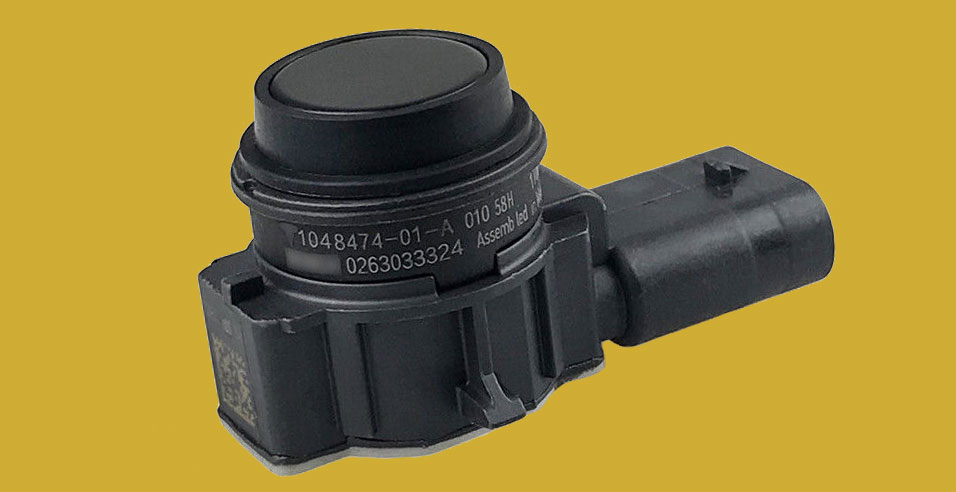

We examine the ultrasonic sensors used in Tesla vehicles, why they can be unreliable, and Tesla’s goal to replace them with Tesla Vision. (Oct-2022)
Ultrasonic Sensors
In the past Tesla has included 6 ultrasonic sensors (USS) on the front bumper and 6 on the rear bumper. These sensors emit sound waves which, if there is an obstruction, will echo the sound back to the sensor. By measuring the time of the echo, a fairly accurate distance of the object can be determined. While the vehicle is stopped, the sensors can detect objects up to 30 feet away.

Unreliable Sensors
These sensors are only effective when the signal is not blocked. If the sensor is covered by mud, ice, snow, or a large bug has smashed into the sensor, the results are either completely dead or give a false reading. The software system must be sophisticated enough to detect these failures and disable any system that relies on faulty data.
These sensors rely on the objects reflecting sound. Some objects absorb sounds, reducing their effectiveness. It may not detect soft, curved, thin, and small objects. Some shapes, such as poles, often become invisible to these sensors, as the sound is reflected in all directions rather than directly back to the sensor.
While less of an issue, external large sounds can overwhelm the sensors. For example, when traveling at moderate speeds, wind noise on the sensor can produce false readings.
When the sensors are in the best-operating conditions, the distance accuracy can be quite good, but the locational accuracy is quite poor. As the object gets very close between two sensors, objects may disappear completely.
Costs
Munro associates performed a parts cost analysis of the Tesla ultrasonics system. This includes the sensors, wiring harnesses, electronics, and other parts. Other costs are our estimates. Generally, beyond the parts and labor costs, these costs are doubled or tripled to include overhead, profit, and other items to arrive at the cost to the consumer.
This means the cost of the vehicle theoretically could be reduced by $250 or so by the removal of the Ultrasonics system while maintaining the existing margins. Tesla could elect to pass that savings back to the consumer, or instead, not pass a price increase caused by other components that have increased in cost.
| Item | Cost |
|---|---|
| Ultrasonic Sensors (12) | $96 |
| Other required parts | $18 |
| Installation & testing labor | $20 |
| Overhead, stocking, warranty reserve, profit | $120 |
| Total cost to consumer | $254 |
Vehicle Features
There are a number of vehicle features that have relied on ultrasonic sensors in the past:
- Park Assist – alerts for objects when traveling less than 5 mph
- Autopark – used to automatically move into parallel or perpendicular parking spaces
- Summon – use the phone app to move the car forward or reverse
- Smart Summon – have the vehicle navigate from a parking space to your location
We do not believe any safety systems, Autopilot, and FSD rely on inputs from the ultrasonic sensors.
Tesla’s Removal Plan
- For the Model 3 and Model Y in most markets – Production since October 2022 no longer includes ultrasonic sensors
- For the Model S and Model X –Production sometime in 2023 will no longer include front or rear ultrasonic sensors
The complete details are available in the Tesla Vision Update post.
Advantages of Sensor Removals
- More accurate object detection and localization with cameras
- Eliminates significant costs
- Reduced production risks if parts are unavailable (supply issues)
- Less weight (which slightly improves range)
- The vehicle becomes more reliable with fewer things to fail
- Minor fascia bumps have no effect (otherwise can cost $200 to reinstall a popped sensor)
- Reduced aerodynamic drag (slight)
- Improved aesthetics with elimination of sensor warts
Disadvantages of Sensor Removals
- Some features are temporarily disabled until implemented with Tesla Vision
- A distance measurement may be inaccurate towards a large, nearby, very clean, single-color wall
- While parked and the vehicle is off, if a new small object is added, low to the ground and less than 3 feet in front of the car, the object may not be detectable*
* This is the same for humans, although, with a lower eye position than cameras, the area immediately in front of the car that is invisible is larger.
We expect when moving forward with Tesla’s persistence technology, the system can remember items such as curbs or parking blocks that move from the camera’s vision to the hidden area in front of the car. When later starting up, the vehicle’s memory is aware of those hidden objects, even though they are not visible from the cameras.